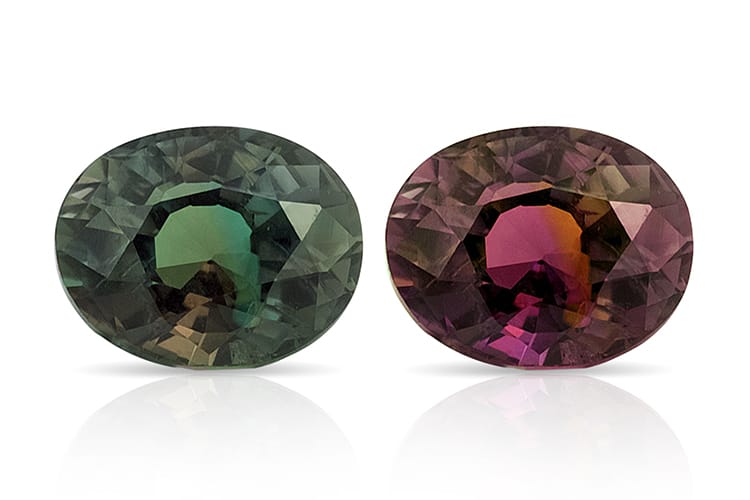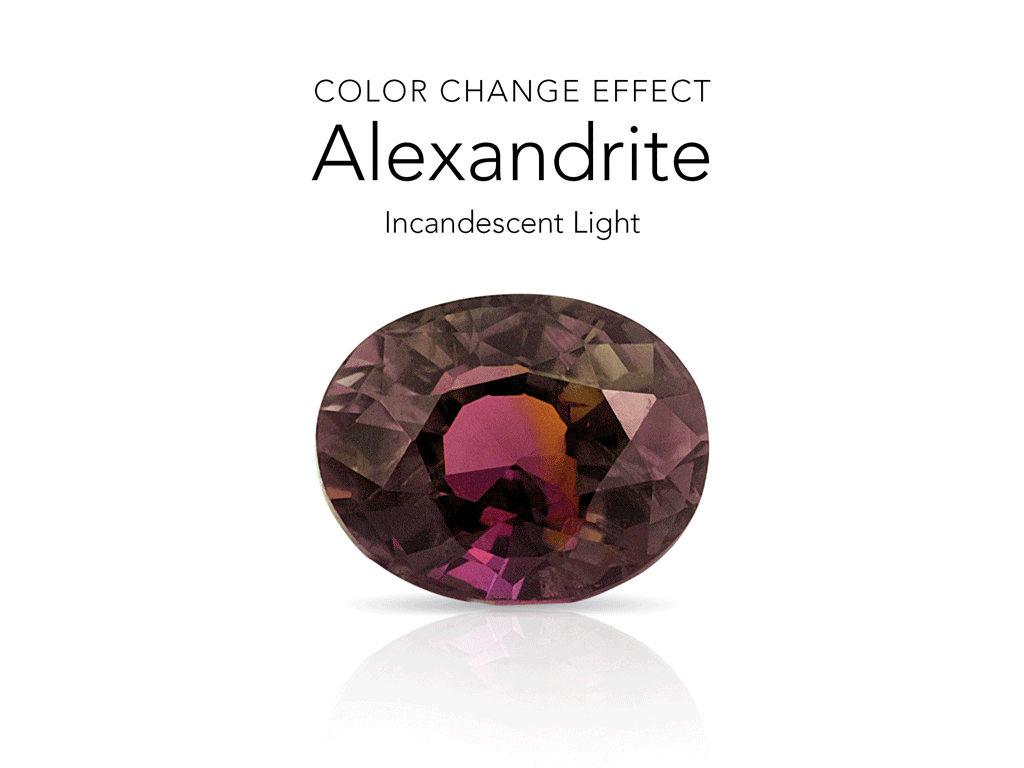Guide to Alexandrite & Chrysoberyl

History, Lore and Appreciation
Of all of the mineral species, chrysoberyl has the most notable phenomenal varieties – in the sense that it possesses unique optical characteristics known as phenomena. Alexandrite, a rare variety of chrysoberyl, exhibits a chameleon-like color change. On rare occasions, these color-change gems exhibit a second phenomenon, called cat’s eye or chatoyancy, seen as a narrow bright line on the surface that appears to move as the gem is turned. This phenomenon is caused by reflections of light from parallel needle-like inclusions.
Alexandrite shows a color-change effect and exhibits reddish hues under incandescent light and bluish-green hues in daylight (or daylight equivalent). Alexandrite was discovered in Russia’s Ural Mountains in early 1830, and the deposit along the Takovaya River began to be worked by 1833. At the time, the color-change gem was named after Tsarevich Alexander Nikolaevich, the future Czar Alexander II.
Among the most cherished gems that exhibit chatoyancy is cat’s eye chrysoberyl sometimes, though rarely, referred to as cymophane. This phenomenon is caused by inclusions; minute fibers of the mineral rutile that are oriented parallel to one another throughout the chrysoberyl. In gems that are properly oriented and cut en cabochon, this silvery, floating line appears when a strong or pinpointed light is directed perpendicular to the gem’s surface. Cat’s eye stones are best viewed in direct light such as sunlight.
An indistinct cat’s eye effect, observed as a broad sheen along the gem’s surface, is caused by a multitude of randomly oriented included needles. Yellow to greenish chrysoberyl is the standard bearer for the name of the species. Chrysos is a Greek word meaning “golden,” and berilos (also Greek), form the root for the chrysoberyl name.
It is worth noting that chrysoberyl is not a form of beryl, which is an entirely different mineral species.

Birthstones and Anniversaries
Alexandrite is one of the birthstones used for the month of June, along with pearl. Alexandrite is also the gemstone for a 55th wedding anniversary.
Description and Properties
Chrysoberyl is a beryllium and aluminum oxide, with the chemical formula: BeAl2O4 and it forms in the orthorhombic crystal system. Non-phenomenal chrysoberyl is transparent to semi-transparent, comprising a range of colors. Chrysoberyl can be yellow, greenish-yellow to yellow-green, green and a rare vanadium-rich chrysoberyl that is a pale bluish green. The phenomenal varieties include alexandrite and cat’s eye chrysoberyl. The alexandrite variety contains gems that vary from transparent to semi-transparent, and whose color appears different depending on the light it is viewed in. Cat’s eye chrysoberyl is opaque to semi-transparent, containing minute parallel inclusions that cause chatoyancy when the gems are fashioned as cabochons.
Among natural gems, non-phenomenal chrysoberyl may be confused with yellow or greenish sapphire, grossular garnet and some spinel, due to their color overlap.
Trained gemologists may easily identify and separate these gems based on their optical and physical characteristics.
Alexandrite may be confused with color-change garnet and color-change sapphire, which often exhibit overlapping colors and color-change phenomena. Cat’s eye chrysoberyl tends to be straightforward to identify based on its optical characteristics, however some very convincing look-alikes do exist: cat’s eye opal, scapolite, kornerupine, tourmaline and quartz – may look similar. Here again, in the case of alexandrite and cat’s eye, a trained gemologist may easily separate them from other visually similar gemstones.
Colors:
- Chrysoberyl: Light to medium yellow to yellowish green, grayish green, bluish green, brown to yellow-brown to light blue.
- Alexandrite (daylight): Yellowish, brownish, grayish or bluish green
- Alexandrite (incandescent light): Orangey or brownish red to purplish red.
Refractive Index: 1.746 to 1.755
Birefringence: 0.004 to 0.006
Specific Gravity: 3.73 (±0.02)
Cause(s) of color: Predominantly iron and chromium in chrysoberyl, chromium in alexandrite and iron (and sometimes chromium in rare, cat’s eye alexandrite). Vanadium is the cause of color in bluish green chrysoberyl.
Mohs Hardness: 8.5.
Internal identifying characteristics: Multi-phase inclusions, hollow tubes, mica platelets, calcite, and metal sulphide inclusions in chrysoberyl and alexandrite. Silk-like bands of minute needles are found in cat’s eyes, and are the cause of chatoyancy.
Treatments
Chrysoberyl generally is not treated, to enhance color or diminish the appearance of inclusions. Although, treatments such as neutron irradiation have been used in the past to obtain brown-colored cat’s eye.
Collector Quality
Alexandrite and cat’s eye chrysoberyl are quite rare to begin with and as such highly collectible due to their exotic, phenomenal qualities. A premium is placed on gems with a strong color change, since with alexandrite a predominantly “muddy” mix of greens, browns and reds tends to be the norm, resulting in a vague color change.
With cat’s eyes, a strong, sharp and unwavering silvery line that is visible from girdle-to-girdle is highly desirable, accompanied by rich green, yellow or brown colors. Cat’s eye alexandrite is especially collectible since they exhibit two phenomena. An additional and easy confirmation of quality for cat’s-eyes is to shine a direct light towards the gem at an oblique angle. In fine, semi-translucent gems, a “milk and honey” effect can be observed. This shows strong brownish to saturated yellow “honey” colors on one side of the gem, and a milky translucence on the other. In all collector varieties, size matters since alexandrite as well as cat’s eyes tend to be found mostly in small sizes, generally under a carat.
Finally, collectors have become much more discriminating about the quality of cut – symmetry, orientation, crisp facets and facet junctions and appealing outlines – since such aspects tend to show phenomena at its very best and because the overall effect is more pleasing to the eye.
Localities
Chrysoberyl, while rare as an occurrence, is found on several continents – Africa, South America and Asia. Sources for chrysoberyl and alexandrite include Sri Lanka, Myanmar, Brazil, Kenya, Tanzania, Madagascar, India, Australia and Russia.
Cutting, Care and Cleaning
With a hardness of 81/2 and excellent toughness, chrysoberyl is extremely resilient for use in jewelry. It is never a good idea to wear gems during any type of arduous work or exercise. However, chrysoberyl may be worn daily under normal conditions. Most chrysoberyl jewelry may be cleaned in an ultrasonic cleaner unless there are preconditions, such as a fractured gem. Otherwise, a damp cloth and warm soapy water are generally enough to clean chrysoberyl gems and jewelry.
Source: CIBJO Retailer Reference Guide, cibjo.org.